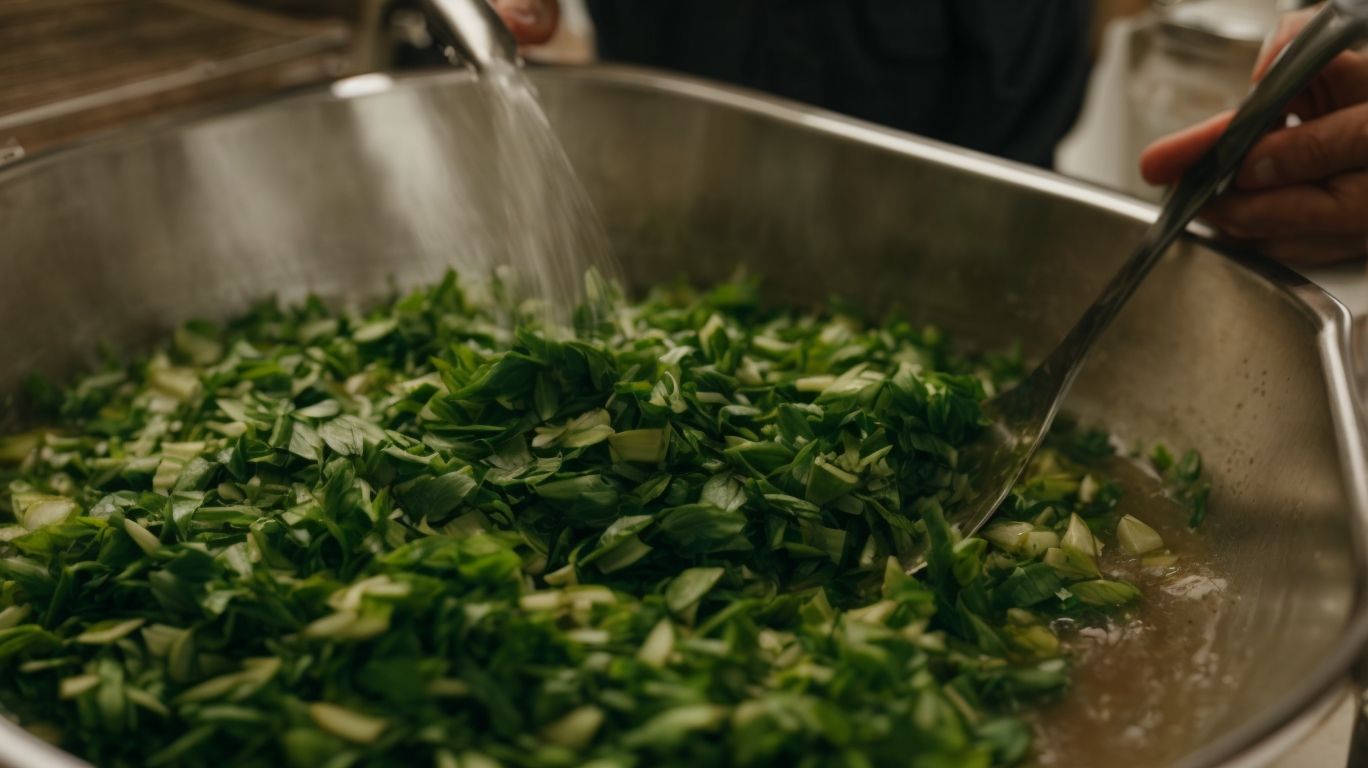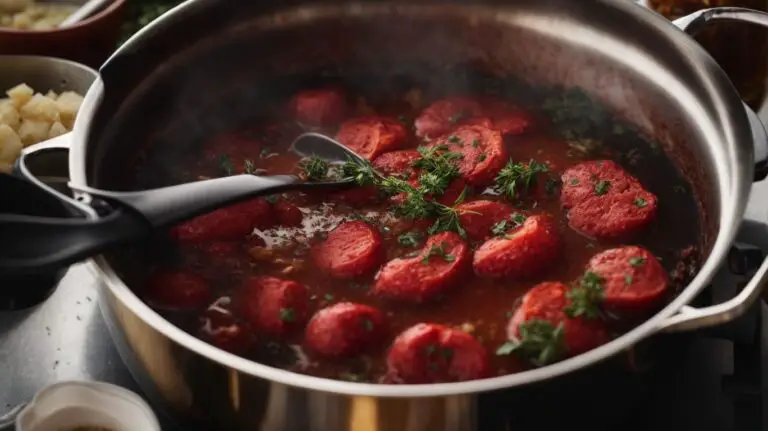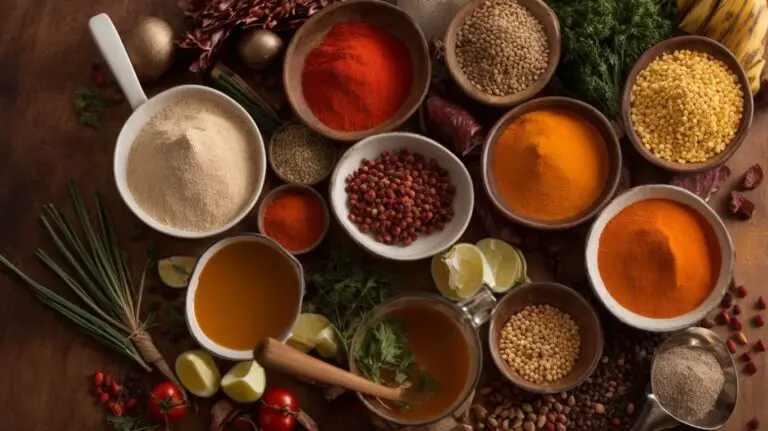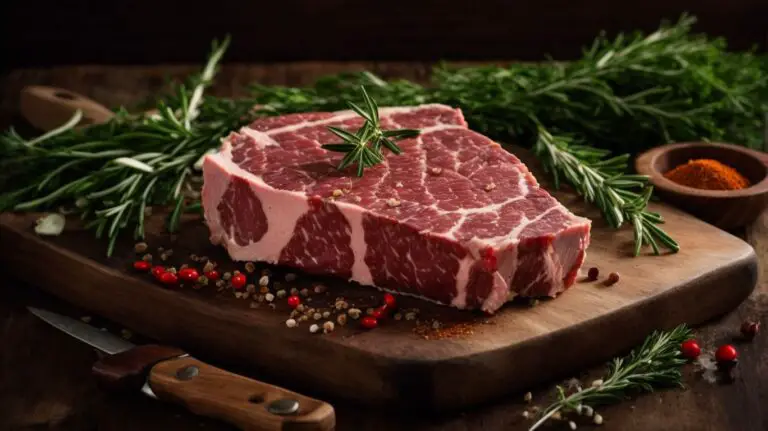How to Cook Talbos?
Looking to add a healthy and delicious green vegetable to your cooking repertoire? Consider Talbos, a versatile leafy green with numerous health benefits.
Discover all you need to know about Talbos, from its health benefits to preparation and cooking methods. Join Chris Poormet to explore mouth-watering Talbos recipes and essential cooking tips.
Let’s start cooking!
Key Takeaways:
About Chris Poormet and Poormet.com
Chris Poormet, a former chef known for his accolades in food photography, is the proud owner of Poormet.com, a renowned blog where he shares recipes and tips that have earned him the prestigious title of Culinary Blogger of the Year.
Chris transitioned from the fast-paced environment of professional kitchens to the creative realm of food styling through his passion for capturing visually stunning dishes. He honed his skills in photography and storytelling, showcasing each recipe with an artistic eye that entices his audience. The inception of Poormet.com was a reflection of his desire to combine his culinary expertise with his love for visual arts, creating a space where food enthusiasts can find inspiration and practical guidance.
What is Talbos?
Talbos, also known as sweet potato leaves, is a popular ingredient in Filipino cuisine, particularly featured in dishes like Ensaladang Talbos ng Kamote. The term ‘Talbos’ originates from the Tagalog language.
In Philippine culinary culture, Talbos signifies more than just a mere ingredient – it symbolizes a connection to the land and a celebration of traditional flavors. The versatility of sweet potato leaves allows them to be incorporated in various cooking methods, from stir-frying to boiling. One famous dish, Ensaladang Talbos ng Kamote, showcases the leaves in a refreshing salad, typically mixed with tomatoes, onions, and a tangy dressing.
What Are the Health Benefits of Talbos?
The health benefits of Talbos, or sweet potato leaves, are abundant, offering a rich source of essential nutrients and vitamins that contribute to overall well-being and vitality.
These vibrant green leaves are packed with nutritional richness, providing a significant amount of vitamin C which boosts the immune system and promotes collagen production for healthy skin. Talbos also contain substantial levels of vitamin A, crucial for eye health and cell development. Plus vitamins, they are a good source of iron and calcium, supporting strong bones and preventing anemia. The presence of antioxidants in sweet potato leaves helps combat oxidative stress, reducing the risk of chronic diseases.
How to Prepare Talbos for Cooking?
Preparing Talbos for cooking involves specific steps to ensure optimal flavor and texture in your dishes. Understanding the right techniques is essential for a delicious culinary experience.
When selecting Talbos, opt for vibrant, fresh sweet potato leaves with no wilting or discoloration. Before cooking, thoroughly wash the leaves in cold water to remove any dirt or impurities. Trim the stems and tough parts of the leaves, retaining the tender greens for cooking.
- For a simple sautéed dish, heat oil in a pan, add garlic, onions, and chili flakes for added flavor.
- Cook the Talbos until they wilt slightly, maintaining their vibrant color and crisp texture.
- Season with salt, pepper, and a squeeze of lemon juice for a refreshing finish.
Experiment with different cooking methods and ingredients to discover your favorite way to enjoy Talbos!
How to Clean Talbos?
Cleaning Talbos, or sweet potato leaves, is a crucial initial step in the preparation process to remove dirt, impurities, and ensure food safety standards are met.
Start by carefully separating the talbos from the main stem. Fill a large bowl with cold water, submerge the leaves, and gently swish them around to loosen any debris.
Next, carefully inspect each leaf, discarding any that are wilted or discolored. Rinse the leaves under running water to remove any remaining dirt or residue. Repeat this process until the water runs clear, indicating the leaves are thoroughly clean.
Remember to handle the talbos with care to prevent bruising or damage. Once cleaned, pat them dry with a clean kitchen towel or use a salad spinner to remove excess water. These steps ensure that your talbos are clean, fresh, and ready for use in your favorite recipes.
How to Cut Talbos?
Mastering the art of cutting Talbos, or sweet potato leaves, requires precision, knife skills, and knowledge of the ideal cutting techniques to achieve the desired texture and presentation in your dishes.
Regarding slicing Talbos, a sharp knife is your best friend. Make sure to use a sharp chef’s knife or a santoku knife for clean cuts without bruising the leaves. One technique is the chiffonade cut, where you stack several leaves, roll them tightly, and slice thinly for delicate ribbons that add elegance to salads. Alternatively, for a rustic touch, go for a rough chop by cutting the leaves into irregular pieces. Whichever method you choose, always remember to wash the leaves thoroughly and pat them dry before cutting to maintain their freshness and flavor.
What Are the Different Ways to Cook Talbos?
Exploring the diverse culinary possibilities, there are numerous ways to cook Talbos, ranging from stir-frying and boiling to steaming, grilling, and baking, each method offering unique flavors and textures.
When stir-frying Talbos, the high heat quickly cooks the leaves, maintaining their vibrant color and crispiness, accentuating their fresh flavor.
Boiling Talbos in a savory broth can infuse them with rich umami notes, making them tender yet flavorful.
Steaming Talbos preserves their nutrients and delicate taste, resulting in a light and healthy dish.
When grilled, Talbos take on a delightful smoky flavor that pairs well with juicy meats or tangy dressings.
Baking Talbos with seasoned breadcrumbs creates a satisfying crispy texture, perfect for a unique side dish.
Stir-Frying Talbos
Stir-frying Talbos is a popular method that involves quick cooking over high heat to preserve the vibrant colors, flavors, and nutrients of sweet potato leaves, resulting in a delicious and nutritious dish.
When stir-frying Talbos, it is crucial to start by washing the sweet potato leaves thoroughly and allowing them to dry completely to prevent excess moisture during cooking. Heat a wok or large skillet over high heat and add a high-smoke-point oil like peanut or canola oil.
Once the oil is shimmering, add aromatics like minced garlic and ginger, allowing them to release their fragrant oils before adding the Talbos to the pan. Keep the ingredients moving constantly with a quick stir-fry motion to ensure even cooking.
For seasoning, a combination of soy sauce, oyster sauce, and a touch of sugar can elevate the flavors of this dish. Add a splash of broth or water if needed to create a light sauce that coats the leaves.
Boiling Talbos
Boiling Talbos is a simple yet effective cooking method that helps retain the natural flavors and tenderness of sweet potato leaves, making it a versatile ingredient for various dishes.
For ideal boiling techniques, start by thoroughly washing the sweet potato leaves to remove any dirt or impurities. Place a pot of water on the stove and bring it to a gentle boil. Once the water is boiling, add a pinch of salt to enhance the flavor of the Talbos.
- Timing is crucial when boiling Talbos
- as overcooking can result in a mushy texture,
- while undercooking may leave the leaves tough and bitter.
To balance the flavors, consider adding a clove of garlic or a sprinkle of black pepper to the boiling water.
Steaming Talbos
Steaming Talbos is a gentle cooking technique that helps retain the natural nutrients, colors, and flavors of sweet potato leaves, offering a healthy and vibrant dish for consumption.
Regarding steaming Talbos, the process involves exposing the leaves to gentle heat, maintaining their texture and nutritional integrity. To achieve optimal results, it is essential to monitor the steaming time carefully, ensuring the leaves are cooked through yet retain a desirable crunch. Seasoning options like a sprinkle of salt, a drizzle of olive oil, or a splash of citrus juice can enhance the flavors without compromising the health benefits. By steaming Talbos, you can create a visually appealing dish that not only nourishes the body but also delights the senses.
Grilling Talbos
Grilling Talbos imparts a delightful smoky flavor to the sweet potato leaves, adding a unique charred essence that complements various dishes and adds a savory touch to the overall culinary experience.
When grilling Talbos, it’s essential to pay attention to the cooking technique to achieve that perfect balance of char and tenderness. One effective method is to lightly brush the leaves with olive oil before placing them on a preheated grill to prevent sticking and enhance the flavor profile.
- For those who prefer a subtle taste, grilling the Talbos for a shorter duration will maintain a fresh, crisp texture while infusing a hint of smokiness.
- Alternatively, if you enjoy bold flavors, leaving the leaves on the grill a bit longer will intensify the charred notes, creating a more robust taste.
Experimenting with different grilling times can help you tailor the flavor to suit your palate.
Baking Talbos
Baking Talbos offers a unique culinary experience by transforming sweet potato leaves into crispy, flavorful chips or snacks that are both healthy and satisfying, ideal for creative and nutritious culinary explorations.
Regarding the innovative process of baking Talbos, it’s essential to pay attention to the technique to achieve that perfect crunch without compromising on the nutritional value of this leafy goodness. One way to achieve this is by thinly slicing the sweet potato leaves and evenly arranging them on a baking sheet to ensure even cooking. Baking at a moderate temperature allows the Talbos to crisp up beautifully while retaining their natural flavors.
What Are Some Delicious Talbos Recipes?
Discover a range of delectable Talbos recipes that showcase the versatility and flavors of sweet potato leaves, including tantalizing dishes like Talbos Salad with Vinaigrette Dressing, Talbos and Shrimp Stir-Fry, Grilled Talbos with Lemon and Garlic, and Baked Talbos and Cheese Casserole.
For an infusion of flavors that will excite your taste buds, try the Talbos Salad with Vinaigrette Dressing. The combination of fresh sweet potato leaves, cherry tomatoes, cucumbers, and a zesty vinaigrette creates a refreshing and light dish, perfect for a summer afternoon. To make this salad, wash and chop the Talbos leaves, then toss them with the diced tomatoes and cucumbers. Drizzle the vinaigrette over the salad just before serving for the ultimate burst of freshness.
Another delightful option is the Talbos and Shrimp Stir-Fry, which pairs the earthy taste of sweet potato leaves with succulent shrimp and a medley of stir-fry vegetables. Sauté minced garlic and ginger in a hot pan, add the shrimp and quickly cook until pink. Toss in the Talbos leaves and vegetables, stir-frying until everything is coated in the flavorsome sauce. Serve this vibrant dish over steamed rice for a complete and satisfying meal.
Talbos Salad with Vinaigrette Dressing
Indulge in the refreshing flavors of Talbos Salad with Vinaigrette Dressing, a vibrant and nutritious dish that combines the crispness of sweet potato leaves with the tangy sweetness of a homemade vinaigrette, creating a delightful culinary experience.
For this delightful recipe, start by gathering fresh sweet potato leaves, cherry tomatoes, cucumber, red onion, and feta cheese. The key to a successful Talbos Salad is in the preparation of the ingredients – wash the sweet potato leaves thoroughly and chop them into bite-sized pieces, slice the cherry tomatoes in halves, thinly slice the cucumber and red onion, and crumble the feta cheese for a creamy touch.
As for the vinaigrette dressing, whisk together olive oil, balsamic vinegar, Dijon mustard, honey, minced garlic, salt, and pepper until emulsified. The balance of tanginess from the vinegar, sweetness from the honey, and depth from the mustard creates a harmonious dressing that complements the freshness of the salad ingredients.
To assemble the salad, gently toss the sweet potato leaves, cherry tomatoes, cucumber, red onion, and feta cheese in a large bowl. Drizzle the vinaigrette dressing over the salad, ensuring each ingredient is coated evenly.
Talbos and Shrimp Stir-Fry
Experience the savory delights of Talbos and Shrimp Stir-Fry, a tantalizing dish that combines the succulence of shrimp with the vibrant flavors of sweet potato leaves, creating a harmonious blend of textures and tastes in each bite.
Begin by sautéing fresh shrimp in a hot pan until they turn pink and slightly caramelized to enhance their flavor profile. Sweet potato leaves, rich in nutrients and earthy notes, are then added to the pan, complementing the brininess of the shrimp with their delicate sweetness.
To elevate the dish further, consider adding a splash of soy sauce for umami depth and a hint of sweetness or a sprinkle of red pepper flakes for a touch of heat.
The key to a successful stir-fry lies in quick cooking over high heat, ensuring that the ingredients retain their individual textures and flavors while melding together harmoniously.
Grilled Talbos with Lemon and Garlic
Savor the aromatic flavors of Grilled Talbos with Lemon and Garlic, a zesty and wholesome dish that combines the smoky essence of grilled sweet potato leaves with the citrusy tang of lemon and the robust aroma of garlic, creating a memorable culinary experience.
Grilling these delicate sweet potato leaves brings out their natural sweetness while adding a hint of charred flavor, enhancing their overall depth. The marinade, crafted with fresh lemon juice, minced garlic, olive oil, salt, and pepper, infuses the talbos with a refreshing citrus kick that perfectly balances the earthy tones of the greens.
As the talbos sizzle on the grill, the garlic caramelizes, releasing its irresistible aroma that wafts through the air, tempting taste buds with its savory allure. This dish is a celebration of simplicity and bold flavors, where each bite offers a harmonious blend of textures and tastes, making it a delightful addition to any outdoor meal.
Baked Talbos and Cheese Casserole
Delight in the comforting flavors of Baked Talbos and Cheese Casserole, a heartwarming dish that combines the earthy richness of sweet potato leaves with the creamy goodness of melted cheese, creating a satisfying and flavorful culinary creation.
For this delectable casserole, start by blanching the Talbos leaves until they are just tender, enhancing their vibrant green color and delicate flavor. The cheese selection is crucial; opt for a blend of sharp cheddar and gooey mozzarella to achieve a perfect balance of tangy and melty textures.
Layer the blanched Talbos with the cheese mixture, creating a harmonious combination between the earthiness of the greens and the richness of the cheese.
What Are Some Tips for Cooking Talbos?
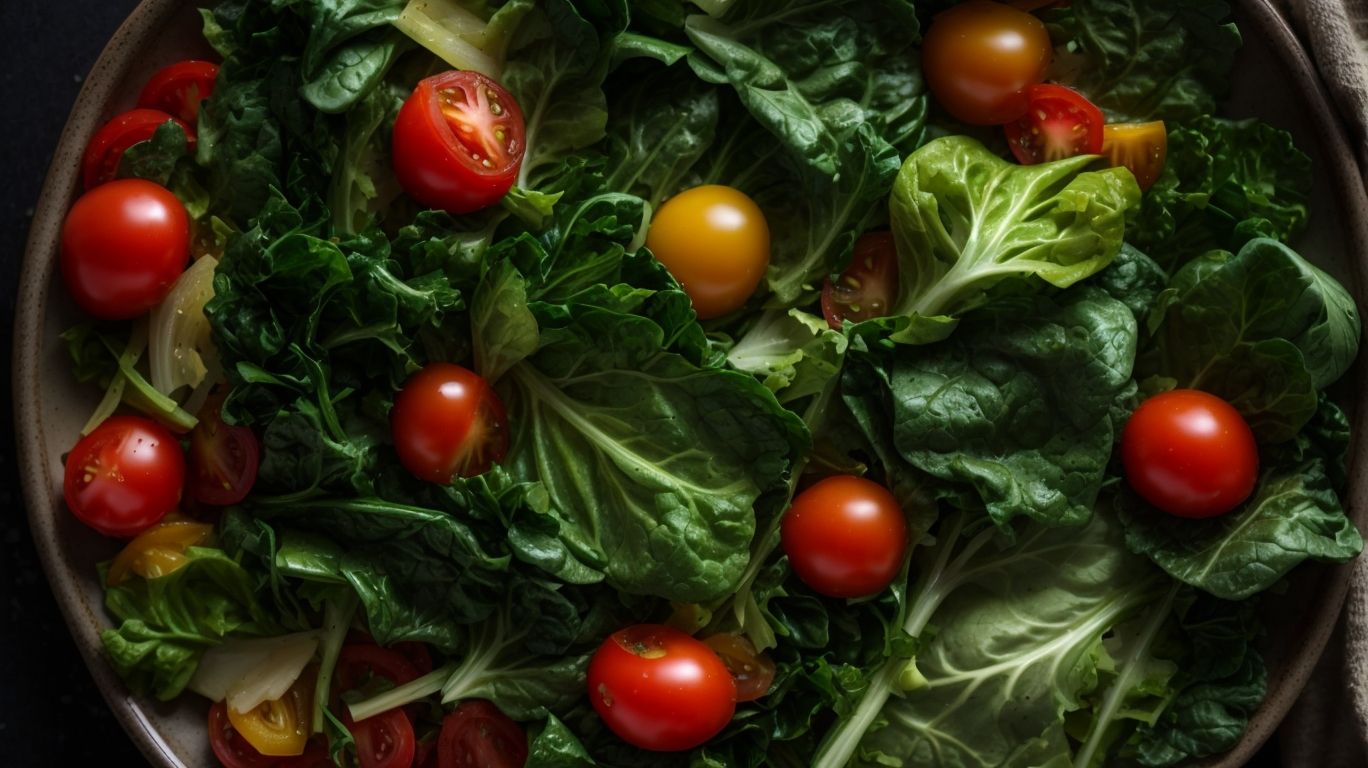
Credits: Poormet.Com – Jack Robinson
Enhance your culinary skills with essential tips for cooking Talbos, ensuring that you use fresh leaves, season to taste, experiment with different flavors, and avoid overcooking to preserve the integrity and flavors of this versatile ingredient.
When working with Talbos, it is crucial to source the freshest leaves possible, as this will significantly impact the final dish’s quality. Seasoning plays a vital role in elevating the natural flavors of the greens, so don’t be afraid to experiment with various herbs, spices, and condiments to find the perfect balance. To achieve optimal cooking results, pay attention to the cooking time and method; overcooking can result in a mushy texture and loss of flavor. Try incorporating Talbos into stir-fries, soups, salads, or even omelets for a creative twist on traditional recipes.
Use Fresh Talbos
Selecting fresh Talbos, or sweet potato leaves, is essential to capture the vibrant colors, textures, and flavors that define this ingredient in your culinary creations, ensuring a high-quality and delightful dining experience.
When choosing Talbos, opt for leaves that are bright green, firm, and free from blemishes or yellowing spots. This indicates their freshness and ensures optimal taste in your dishes. To store them, place the leaves in a plastic bag with a damp paper towel to maintain moisture and crispness. Proper handling involves washing the leaves thoroughly, removing the stems, and chopping them just before cooking to preserve their nutrients and flavors. Incorporating fresh Talbos not only adds visual appeal but also imparts a unique earthy sweetness, complementing various savory dishes like stir-fries, soups, and salads.
Season to Taste
Seasoning Talbos to taste is a crucial step in elevating the flavors and enhancing the culinary experience, allowing you to customize the dish according to your preferences and create a harmonious balance of tastes.
Regarding flavor balance, combining salty, sweet, sour, and umami elements can work wonders. Experimenting with different herbs, spices, and condiments can add depth to the dish. You can play around with classic flavor pairings like garlic and lemon or get creative with unexpected combinations like cinnamon and cayenne pepper. Remember, a little goes a long way; season lightly at first and adjust gradually to avoid overpowering the natural flavors of the Talbos. Don’t shy away from trying out unique seasonings that reflect your personal taste palette. Your seasoning choices can truly transform a simple dish into a culinary masterpiece.
Experiment with Different Flavors
Embark on a culinary adventure by experimenting with different flavors when cooking Talbos, allowing you to discover new taste profiles, culinary combinations, and creative possibilities that enhance your cooking repertoire.
Regarding creating innovative dishes with Talbos, the key lies in balancing contrasting flavors to create a harmonious symphony on the palate. Consider pairing the earthy tones of Talbos with the brightness of citrus fruits or the spice of chili peppers for a tantalizing contrast.
Experimentation with herbs like mint or basil can add a refreshing twist to Talbos-based salads or soups, while a drizzle of balsamic glaze can elevate the flavors of roasted Talbos to new heights.
Don’t Overcook Talbos
Avoiding overcooking Talbos is essential to preserve the natural texture, colors, and flavors of sweet potato leaves, ensuring a satisfying culinary experience with optimal taste and visual appeal.
Properly cooking the Talbos involves closely monitoring the cooking times and utilizing appropriate techniques. The leaves should be just tender enough to maintain a slight crunch while still being easy to chew. Overcooking can result in a mushy texture and loss of the vibrant green color that enhances the visual appeal of the dish.
To achieve the ideal texture and flavor retention, consider blanching the leaves briefly in boiling water before incorporating them into your recipe. This helps to lock in the nutrients and prevent the leaves from becoming limp and overly soft.
Frequently Asked Questions
How to Cook Talbos?
1. What is Talbos and why should I cook it?
Talbos, also known as malunggay leaves, is a versatile and nutritious ingredient that can be cooked in various ways. It is rich in vitamins and minerals, making it a great addition to any dish.
2. How do I prepare Talbos for cooking?
To prepare Talbos, wash the leaves thoroughly and remove any tough stems. You can also blanch the leaves in boiling water for a few seconds to soften them before cooking.
3. What are some popular ways to cook Talbos?
Some popular ways to cook Talbos include sautéing with garlic and onions, adding it to soups and stews, and using it as a filling in omelettes or frittatas. You can also steam or stir-fry Talbos for a healthy side dish.
4. Can I use Talbos in baked dishes?
Yes, you can definitely use Talbos in baked dishes such as quiches, lasagnas, and casseroles. Just make sure to blanch the leaves first and squeeze out any excess water before using them in your dish.
5. How do I store leftover Talbos?
If you have leftover Talbos, store them in an airtight container in the refrigerator for up to 3 days. You can also freeze the leaves for longer storage, but make sure to blanch and dry them before freezing.
6. Are there any other creative ways to use Talbos?
Aside from cooking, you can also use Talbos in smoothies, salads, and as a garnish for dishes. You can also mix it with other herbs and spices to make a flavorful seasoning for meats and vegetables. The possibilities are endless!

